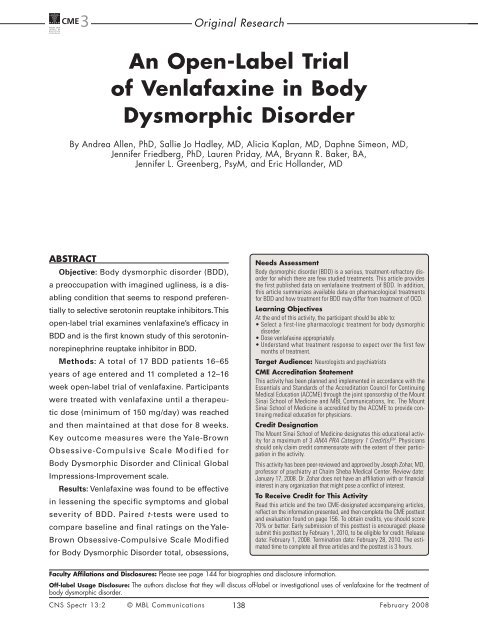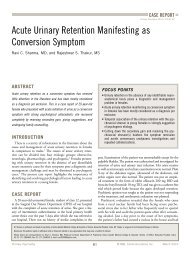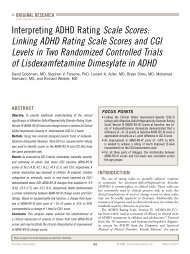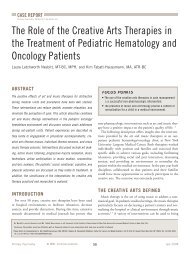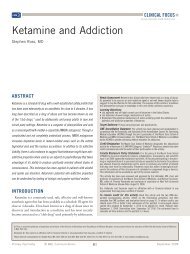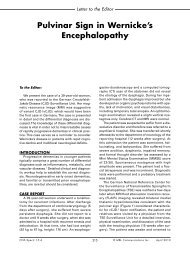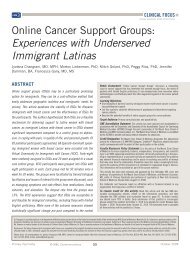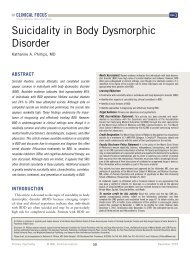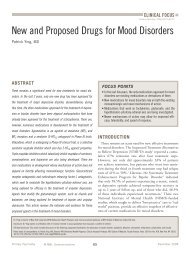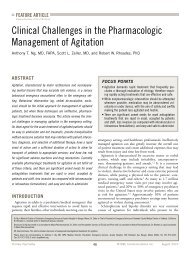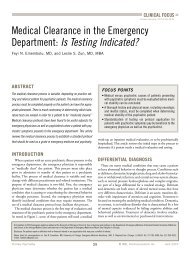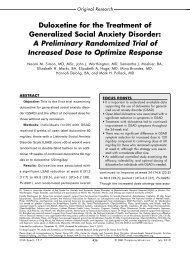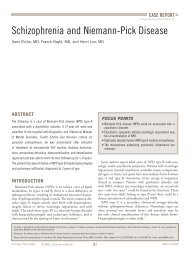An Open-Label Trial of Venlafaxine in Body Dysmorphic Disorder
An Open-Label Trial of Venlafaxine in Body Dysmorphic Disorder
An Open-Label Trial of Venlafaxine in Body Dysmorphic Disorder
You also want an ePaper? Increase the reach of your titles
YUMPU automatically turns print PDFs into web optimized ePapers that Google loves.
CME3<br />
Orig<strong>in</strong>al Research<br />
<strong>An</strong> <strong>Open</strong>-<strong>Label</strong> <strong>Trial</strong><br />
<strong>of</strong> <strong>Venlafax<strong>in</strong>e</strong> <strong>in</strong> <strong>Body</strong><br />
<strong>Dysmorphic</strong> <strong>Disorder</strong><br />
By <strong>An</strong>drea Allen, PhD, Sallie Jo Hadley, MD, Alicia Kaplan, MD, Daphne Simeon, MD,<br />
Jennifer Friedberg, PhD, Lauren Priday, MA, Bryann R. Baker, BA,<br />
Jennifer L. Greenberg, PsyM, and Eric Hollander, MD<br />
ABSTRACT<br />
Objective: <strong>Body</strong> dysmorphic disorder (BDD),<br />
a preoccupation with imag<strong>in</strong>ed ugl<strong>in</strong>ess, is a disabl<strong>in</strong>g<br />
condition that seems to respond preferentially<br />
to selective seroton<strong>in</strong> reuptake <strong>in</strong>hibitors. This<br />
open-label trial exam<strong>in</strong>es venlafax<strong>in</strong>e’s efficacy <strong>in</strong><br />
BDD and is the first known study <strong>of</strong> this seroton<strong>in</strong>norep<strong>in</strong>ephr<strong>in</strong>e<br />
reuptake <strong>in</strong>hibitor <strong>in</strong> BDD.<br />
Methods: A total <strong>of</strong> 17 BDD patients 16–65<br />
years <strong>of</strong> age entered and 11 completed a 12–16<br />
week open-label trial <strong>of</strong> venlafax<strong>in</strong>e. Participants<br />
were treated with venlafax<strong>in</strong>e until a therapeutic<br />
dose (m<strong>in</strong>imum <strong>of</strong> 150 mg/day) was reached<br />
and then ma<strong>in</strong>ta<strong>in</strong>ed at that dose for 8 weeks.<br />
Key outcome measures were the Yale-Brown<br />
Obsessive-Compulsive Scale Modified for<br />
<strong>Body</strong> <strong>Dysmorphic</strong> <strong>Disorder</strong> and Cl<strong>in</strong>ical Global<br />
Impressions-Improvement scale.<br />
Results: <strong>Venlafax<strong>in</strong>e</strong> was found to be effective<br />
<strong>in</strong> lessen<strong>in</strong>g the specific symptoms and global<br />
severity <strong>of</strong> BDD. Paired t-tests were used to<br />
compare basel<strong>in</strong>e and f<strong>in</strong>al rat<strong>in</strong>gs on the Yale-<br />
Brown Obsessive-Compulsive Scale Modified<br />
for <strong>Body</strong> <strong>Dysmorphic</strong> <strong>Disorder</strong> total, obsessions,<br />
Needs Assessment<br />
<strong>Body</strong> dysmorphic disorder (BDD) is a serious, treatment-refractory disorder<br />
for which there are few studied treatments. This article provides<br />
the first published data on venlafax<strong>in</strong>e treatment <strong>of</strong> BDD. In addition,<br />
this article summarizes available data on pharmacological treatments<br />
for BDD and how treatment for BDD may differ from treatment <strong>of</strong> OCD.<br />
Learn<strong>in</strong>g Objectives<br />
At the end <strong>of</strong> this activity, the participant should be able to:<br />
• Select a first-l<strong>in</strong>e pharmacologic treatment for body dysmorphic<br />
disorder.<br />
• Dose venlafax<strong>in</strong>e appropriately.<br />
• Understand what treatment response to expect over the first few<br />
months <strong>of</strong> treatment.<br />
Target Audience: Neurologists and psychiatrists<br />
CME Accreditation Statement<br />
This activity has been planned and implemented <strong>in</strong> accordance with the<br />
Essentials and Standards <strong>of</strong> the Accreditation Council for Cont<strong>in</strong>u<strong>in</strong>g<br />
Medical Education (ACCME) through the jo<strong>in</strong>t sponsorship <strong>of</strong> the Mount<br />
S<strong>in</strong>ai School <strong>of</strong> Medic<strong>in</strong>e and MBL Communications, Inc. The Mount<br />
S<strong>in</strong>ai School <strong>of</strong> Medic<strong>in</strong>e is accredited by the ACCME to provide cont<strong>in</strong>u<strong>in</strong>g<br />
medical education for physicians.<br />
Credit Designation<br />
The Mount S<strong>in</strong>ai School <strong>of</strong> Medic<strong>in</strong>e designates this educational activity<br />
for a maximum <strong>of</strong> 3 AMA PRA Category 1 Credit(s) TM . Physicians<br />
should only claim credit commensurate with the extent <strong>of</strong> their participation<br />
<strong>in</strong> the activity.<br />
This activity has been peer-reviewed and approved by Joseph Zohar, MD,<br />
pr<strong>of</strong>essor <strong>of</strong> psychiatry at Chaim Sheba Medical Center. Review date:<br />
January 17, 2008. Dr. Zohar does not have an affiliation with or f<strong>in</strong>ancial<br />
<strong>in</strong>terest <strong>in</strong> any organization that might pose a conflict <strong>of</strong> <strong>in</strong>terest.<br />
To Receive Credit for This Activity<br />
Read this article and the two CME-designated accompany<strong>in</strong>g articles,<br />
reflect on the <strong>in</strong>formation presented, and then complete the CME posttest<br />
and evaluation found on page 156. To obta<strong>in</strong> credits, you should score<br />
70% or better. Early submission <strong>of</strong> this posttest is encouraged: please<br />
submit this posttest by February 1, 2010, to be eligible for credit. Release<br />
date: February 1, 2008. Term<strong>in</strong>ation date: February 28, 2010. The estimated<br />
time to complete all three articles and the posttest is 3 hours.<br />
Faculty Affilations and Disclosures: Please see page 144 for biographies and disclosure <strong>in</strong>formation.<br />
Off-label Usage Disclosure: The authors disclose that they will discuss <strong>of</strong>f-label or <strong>in</strong>vestigational uses <strong>of</strong> venlafax<strong>in</strong>e for the treatment <strong>of</strong><br />
body dysmorphic disorder.<br />
CNS Spectr 13:2 © MBL Communications 138<br />
February 2008
and compulsions scores; by this measure ven-<br />
lafax<strong>in</strong>e significantly reduced BDD symptoms<br />
overall (P=.012), as well as obsessions (P=.034)<br />
and compulsions specifically (P=.021). A s<strong>in</strong>gle<br />
sample t-test, compar<strong>in</strong>g f<strong>in</strong>al Cl<strong>in</strong>ical Global<br />
Impressions-Improvement scale rat<strong>in</strong>gs to “no<br />
change” (score: 4) found significant improvement<br />
follow<strong>in</strong>g treatment.<br />
Conclusion: <strong>Venlafax<strong>in</strong>e</strong> may be an effective<br />
treatment for BDD, <strong>in</strong>clud<strong>in</strong>g both obsessive and<br />
compulsive symptoms. Controlled research on<br />
venlafax<strong>in</strong>e <strong>in</strong> BDD is recommended.<br />
CNS Spectr. 2008;13(2):138-144<br />
INTRODUCTION<br />
<strong>Body</strong> dysmorphic disorder (BDD) is a disabl<strong>in</strong>g<br />
condition <strong>in</strong> which normal-appear<strong>in</strong>g <strong>in</strong>dividuals<br />
are pa<strong>in</strong>fully preoccupied with an imag<strong>in</strong>ed or<br />
slight defect <strong>in</strong> their appearance. It is a somat<strong>of</strong>orm<br />
disorder that some consider to be an obsessive-compulsive<br />
spectrum disorder 1,2 because <strong>of</strong><br />
its similarities to obsessive-compulsive disorder<br />
(OCD) <strong>in</strong> symptoms, course, age <strong>of</strong> onset, 3,4<br />
and response to primary pharmacologic 5 and<br />
psychological treatments. 6 BDD and OCD differ<br />
primarily <strong>in</strong> the focus <strong>of</strong> their obsessive th<strong>in</strong>k<strong>in</strong>g<br />
and compulsive behaviors and <strong>in</strong> the degree <strong>of</strong><br />
<strong>in</strong>sight, with BDD patients hav<strong>in</strong>g notably poorer<br />
<strong>in</strong>sight than OCD patients. 7 BDD <strong>of</strong>ten leads to<br />
seriously impaired social and occupational function<strong>in</strong>g,<br />
high rates <strong>of</strong> hospitalization, suicidal<br />
ideation, and suicide attempts. 3,4,8-12<br />
Research on pharmacotherapy for BDD is<br />
limited but available reports <strong>in</strong>dicate that BDD<br />
seems to respond to the same first-l<strong>in</strong>e medications<br />
as OCD, specifically the selective seroton<strong>in</strong><br />
reuptake <strong>in</strong>hibitors (SSRIs). <strong>Open</strong>-label<br />
treatment studies and case series 11,13-15 suggest<br />
that SSRIs, such as fluvoxam<strong>in</strong>e, fluoxet<strong>in</strong>e, and<br />
citalopram, can reduce BDD symptoms. More<br />
importantly, controlled studies have found that<br />
the seroton<strong>in</strong> norep<strong>in</strong>ephr<strong>in</strong>e reuptake <strong>in</strong>hibitor<br />
(SNRI) clomipram<strong>in</strong>e 16 and the SSRI fluoxet<strong>in</strong>e 17<br />
can be effective <strong>in</strong> ameliorat<strong>in</strong>g BDD symptoms.<br />
In a double-bl<strong>in</strong>d, controlled pharmacologic<br />
treatment <strong>in</strong>vestigation <strong>of</strong> BDD, Hollander<br />
and colleagues 16 concluded that the SNRI clomipram<strong>in</strong>e<br />
was significantly superior to desip-<br />
Orig<strong>in</strong>al Research<br />
ram<strong>in</strong>e, a selective norep<strong>in</strong>ephr<strong>in</strong>e reuptake<br />
<strong>in</strong>hibitor <strong>in</strong> reduc<strong>in</strong>g overall BDD severity and<br />
specific BDD symptoms; the medication was<br />
equally effective for patients with poor <strong>in</strong>sight<br />
as those with good <strong>in</strong>sight. Phillips and colleagues’<br />
17 study <strong>of</strong> fluoxet<strong>in</strong>e likewise showed<br />
efficacy <strong>in</strong> BDD regardless <strong>of</strong> level <strong>of</strong> <strong>in</strong>sight.<br />
<strong>Venlafax<strong>in</strong>e</strong>, another SNRI, acts similarly<br />
to clomipram<strong>in</strong>e and has been shown to have<br />
fewer side effects and a lower risk <strong>of</strong> adverse<br />
effects than other, older antidepressants, <strong>in</strong>clud<strong>in</strong>g<br />
clomipram<strong>in</strong>e. 18-20 <strong>Venlafax<strong>in</strong>e</strong> is not associated<br />
with the antichol<strong>in</strong>ergic, antihistam<strong>in</strong>e, and<br />
α-adrenergic side effects <strong>of</strong> clomipram<strong>in</strong>e. 21 Case<br />
study and open-label data 21-26 as well as two double-bl<strong>in</strong>d<br />
active comparison studies 27,28 suggest<br />
that venlafax<strong>in</strong>e may be an effective treatment<br />
for OCD. However, one small, placebo-controlled<br />
trial 18,29 failed to show venlafax<strong>in</strong>e efficacy <strong>in</strong><br />
OCD, possibly due to the small sample size and<br />
other methodological limitations. To date, there<br />
are no published studies regard<strong>in</strong>g the efficacy<br />
<strong>of</strong> venlafax<strong>in</strong>e <strong>in</strong> BDD and, given the efficacy<br />
<strong>of</strong> the SNRI clomipram<strong>in</strong>e, may represent an<br />
important option <strong>in</strong> treat<strong>in</strong>g BDD.<br />
Additional research is needed on pharmacotherapy<br />
for BDD. Recent publications have suggested<br />
the augmentation with antipsychotics<br />
may not be as helpful <strong>in</strong> BDD as <strong>in</strong> OCD. The<br />
typical antipsychotic pimozide, although one<br />
<strong>of</strong> the earliest agents shown to be effective <strong>in</strong><br />
monosymptomatic hypochondriasis, failed to<br />
demonstrate any efficacy <strong>in</strong> BDD <strong>in</strong> a placebocontrolled<br />
trial. 30 A small study <strong>of</strong> the atypical<br />
antipsychotic olanzap<strong>in</strong>e 31 showed efficacy <strong>in</strong><br />
only two <strong>of</strong> n<strong>in</strong>e BDD patients.<br />
We hypothesized that venlafax<strong>in</strong>e would be<br />
an effective medication for adults with BDD<br />
s<strong>in</strong>ce it has a similar pharmacologic mechanism<br />
as clomipram<strong>in</strong>e, and the added advantage<br />
<strong>of</strong> hav<strong>in</strong>g a more favorable side-effect<br />
pr<strong>of</strong>ile. This open-label study is the first treatment<br />
study to exam<strong>in</strong>e the efficacy <strong>of</strong> venlafax<strong>in</strong>e<br />
<strong>in</strong> the treatment <strong>of</strong> BDD.<br />
METHODS<br />
Subjects<br />
Seventeen adult outpatient subjects (20–50<br />
years <strong>of</strong> age [mean age: 29.7±8.4 years], two<br />
males, and 15 females) participated <strong>in</strong> this medi-<br />
CNS Spectr 13:2 © MBL Communications 139<br />
February 2008
cation trial; 11 completed treatment (two males,<br />
n<strong>in</strong>e females; age range: 20–50 years [mean<br />
age: 31.2±8.8 years]). Subjects were recruited by<br />
advertis<strong>in</strong>g and other media and by referral from<br />
outside cl<strong>in</strong>icians. This research was approved<br />
by the Mount S<strong>in</strong>ai School <strong>of</strong> Medic<strong>in</strong>e’s <strong>in</strong>stitutional<br />
review board and written <strong>in</strong>formed consent<br />
was obta<strong>in</strong>ed from all participants after the<br />
study procedure and possible side effects were<br />
expla<strong>in</strong>ed and prior to the psychiatric and psychological<br />
<strong>in</strong>terviews.<br />
All patients met criteria for Diagnostic and<br />
Statistical Manual <strong>of</strong> Mental <strong>Disorder</strong>s-Fourth<br />
Edition, Text Revision diagnosis <strong>of</strong> BDD or its<br />
delusional variant as determ<strong>in</strong>ed by a study<br />
psychiatrist and psychologist experienced <strong>in</strong><br />
diagnos<strong>in</strong>g BDD. The pre-admission screen<strong>in</strong>gs<br />
<strong>in</strong>cluded a psychiatric and medical evaluation<br />
by a board-certified or board-eligible psychiatrist<br />
and a diagnostic <strong>in</strong>terview by a licensed psychologist<br />
to determ<strong>in</strong>e whether the patients met<br />
<strong>in</strong>clusion and exclusion criteria.<br />
Exclusion criteria <strong>in</strong>cluded comorbid psychiatric<br />
diagnoses: schizophrenia, schizoaffective<br />
disorder, or any other psychotic disorder not<br />
attributable to delusional BDD; current or lifetime<br />
bipolar disorder; current or recent (past 2 months)<br />
substance abuse or dependence; or recent suicide<br />
attempt or suicidal ideation that warranted<br />
consideration <strong>of</strong> hospitalization. Patients could<br />
not have used a psychotropic medication for the<br />
treatment <strong>of</strong> BDD (SSRI nor SNRI) with<strong>in</strong> 2 weeks<br />
<strong>of</strong> start <strong>of</strong> the trial (6 weeks for fluoxet<strong>in</strong>e). Of<br />
the 17 subjects, 7 were SSRI naïve and 10 had<br />
prior failed SSRI trials; one subject had tried only<br />
one SSRI (paroxet<strong>in</strong>e) and the rest had from two<br />
to four different prior SSRI trials (an average <strong>of</strong><br />
2.6 prior trials), many, though not all, <strong>of</strong> the trials<br />
would be considered adequate, while the rest<br />
were discont<strong>in</strong>ued due to adverse side effects.<br />
Patients were also excluded if they had any significant,<br />
unstable medical problems as were females<br />
who were pregnant, breast feed<strong>in</strong>g, or not us<strong>in</strong>g<br />
adequate contraception.<br />
Procedure<br />
Patients who met <strong>in</strong>clusion and exclusion<br />
criteria were entered <strong>in</strong>to a 12–16 week openlabel<br />
trial <strong>of</strong> venlafax<strong>in</strong>e. Patients were cont<strong>in</strong>ued<br />
past 12 weeks and up to 16 weeks if they<br />
had not been on a m<strong>in</strong>imally adequate (150 mg/<br />
Orig<strong>in</strong>al Research<br />
day) dose for 8 weeks; all patients had been on<br />
the adequate dose for 8 weeks by the 16-week<br />
po<strong>in</strong>t. Both a psychiatrist and a psychologist<br />
adm<strong>in</strong>istered key basel<strong>in</strong>e rat<strong>in</strong>gs, <strong>in</strong>clud<strong>in</strong>g<br />
the Cl<strong>in</strong>ical Global Impressions-Severity scale<br />
(CGI-S), 32 Yale-Brown Obsessive-Compulsive<br />
Scale Modified for <strong>Body</strong> <strong>Dysmorphic</strong> <strong>Disorder</strong><br />
(BDD-YBOCS), 33 Brown Assessment <strong>of</strong> Beliefs<br />
Scale, 34 Overvalued Idea Scale, 35 and the<br />
Schneier Disability Scale. 36 In addition, subjects<br />
completed the self-report version <strong>of</strong> the <strong>Body</strong><br />
<strong>Dysmorphic</strong> <strong>Disorder</strong> Exam<strong>in</strong>ation (BDDE-SR), 37<br />
the Beck Depression Inventory II (BDI-II), 38,39 and<br />
the Beck <strong>An</strong>xiety Inventory (BAI). 40<br />
Subjects met with their study psychiatrist<br />
every other week for the first 4 weeks and<br />
monthly thereafter for medication management<br />
and rat<strong>in</strong>gs. Dur<strong>in</strong>g each visit, the study<br />
psychiatrist adm<strong>in</strong>istered the Cl<strong>in</strong>ical Global<br />
Impressions-Improvement scale (CGI-I) and<br />
BDD-YBOCS, asked about side effects <strong>of</strong> the<br />
medication s<strong>in</strong>ce the last visit, and provided<br />
venlafax<strong>in</strong>e. Patients were started at a dose <strong>of</strong><br />
37.5 mg/day and <strong>in</strong>creased to a m<strong>in</strong>imum <strong>of</strong> 150<br />
mg/day, generally over the first 4 weeks <strong>of</strong> the<br />
study, and then ma<strong>in</strong>ta<strong>in</strong>ed at that dose for 8<br />
weeks. Dosage and titration were tailored to<br />
each <strong>in</strong>dividual subject’s current BDD symptoms<br />
and medication side effects. The actual range<br />
<strong>of</strong> f<strong>in</strong>al doses for the completers was 150–225<br />
mg/day with a mean f<strong>in</strong>al dose <strong>of</strong> 164±30.34 mg/<br />
day. Patients completed the study <strong>in</strong> an average<br />
<strong>of</strong> 13±1.70 weeks. At the study endpo<strong>in</strong>t, the<br />
psychiatrist and psychologist each repeated the<br />
basel<strong>in</strong>e measures, <strong>in</strong>clud<strong>in</strong>g the CGI-I rather<br />
than the CGI-S, and the patient completed the<br />
BDDE-SR, BAI, and BDI-II.<br />
Statistics<br />
For most measures, pre-post analyses were<br />
done us<strong>in</strong>g paired t-tests compar<strong>in</strong>g basel<strong>in</strong>e<br />
rat<strong>in</strong>gs with endpo<strong>in</strong>t rat<strong>in</strong>gs. In the case <strong>of</strong> the<br />
CGI-I, a s<strong>in</strong>gle sample t-test was conducted compar<strong>in</strong>g<br />
the endpo<strong>in</strong>t rat<strong>in</strong>gs with no change (a<br />
rat<strong>in</strong>g <strong>of</strong> 4). The key evaluative measures were<br />
the BDD-YBOCS and CGI-I rat<strong>in</strong>gs by the treat<strong>in</strong>g<br />
psychiatrist. For the key measures, data was<br />
analyzed for both completers and for the <strong>in</strong>tentto-treat<br />
sample with the last observations carried<br />
forward. Pearson correlations were used to<br />
exam<strong>in</strong>e relationships between variables.<br />
CNS Spectr 13:2 © MBL Communications 140<br />
February 2008
RESULTS<br />
<strong>Venlafax<strong>in</strong>e</strong> was found to be effective <strong>in</strong> lessen<strong>in</strong>g<br />
the global BDD severity and specific BDD<br />
symptoms <strong>of</strong> the 11 completers. (See the Table<br />
for a summary <strong>of</strong> key measures.) There was a<br />
significant decrease <strong>in</strong> overall BDD severity as<br />
measured by the CGI-I rat<strong>in</strong>gs completed by the<br />
treat<strong>in</strong>g psychiatrist and the study psychologist.<br />
Orig<strong>in</strong>al Research<br />
BDD symptoms were reduced significantly based<br />
on both the psychiatrist’s and the psychologist’s<br />
rat<strong>in</strong>gs on the BDD-YBOCS overall, as well as<br />
the compulsions subscale. Obsessions were<br />
reduced significantly based on the psychiatrist’s<br />
BDD-YBOCS rat<strong>in</strong>gs but did not quite reach significance<br />
based on the psychologist’s rat<strong>in</strong>gs.<br />
The f<strong>in</strong>d<strong>in</strong>gs were equally strong for the <strong>in</strong>tent-<br />
TABLE.<br />
Cl<strong>in</strong>ical Rat<strong>in</strong>gs <strong>of</strong> Subjects with <strong>Body</strong> <strong>Dysmorphic</strong> <strong>Disorder</strong> Treated with <strong>Venlafax<strong>in</strong>e</strong><br />
Measure<br />
Psychiatrist’s Rat<strong>in</strong>gs<br />
BDD-YBOCS<br />
Basel<strong>in</strong>e (Mean±SD)<br />
Completers (N=11)<br />
Endpo<strong>in</strong>t (Mean±SD) t-test Significance<br />
Total 34.64±5.09 26.55±11.28 3.07 P=.01<br />
Obsessions 14.73±2.20 11.45±5.03 2.45 P=.03<br />
Compulsions 14.82±1.20 11.55±4.93 2.73 P=.02<br />
CGI-I N/A 2.73±0.91 4.67 P
to-treat sample. Note that the 12-week rat<strong>in</strong>gs<br />
by the treat<strong>in</strong>g psychiatrist also showed significant<br />
improvement on the key outcome variables:<br />
the CGI-I (t=3.634, df=10, P=.005) and total BDD-<br />
YBOCS scores (t=2.985, df=10, P=.014). The Figure<br />
shows the change over time <strong>in</strong> the rat<strong>in</strong>gs by the<br />
psychiatrist. As <strong>in</strong>dicated, the rat<strong>in</strong>gs for both the<br />
CGI-I and the BDD-YBOCS are significantly different<br />
from basel<strong>in</strong>e by week 4.<br />
Based on the treat<strong>in</strong>g psychiatrists’ rat<strong>in</strong>gs, seven<br />
<strong>of</strong> 11 patients responded by hav<strong>in</strong>g a CGI-I rat<strong>in</strong>g <strong>of</strong><br />
1 or 2 (four <strong>of</strong> 11 patients), <strong>in</strong>dicat<strong>in</strong>g “very much”<br />
or “much improved,” respectively, or a BDD-YBOCS<br />
reduction <strong>of</strong> >33% (five <strong>of</strong> 11 patients).<br />
<strong>Venlafax<strong>in</strong>e</strong> may have improved <strong>in</strong>sight <strong>in</strong> BDD<br />
patients when measured by the Overvalued Idea<br />
Scale; although the psychiatrist’s rat<strong>in</strong>gs <strong>of</strong> <strong>in</strong>sight<br />
did not show a significant improvement after treatment,<br />
there was a trend <strong>in</strong> that direction and there<br />
was significant improvement based on the psychologists’<br />
rat<strong>in</strong>gs. This trend was not found for<br />
the Brown Assessment <strong>of</strong> Beliefs Scale or for the<br />
<strong>in</strong>sight question on the BDD-YBOCS (psychiatrist:<br />
t=1.00, df=10, P=.341; psychologist: t=–.90, df=10,<br />
P=.391). Change on the Schneier Disability Scale<br />
also varied by rater. The rat<strong>in</strong>gs by the psychiatrist<br />
did not show significant improvement but those by<br />
the psychologist did show significant improvement<br />
(psychiatrist: t=–1.12, df=10, P=.289;<br />
psychologist: t=2.62, df=10, P=.026).<br />
FIGURE.<br />
CGI-I and BDD-YBOCS Over Time<br />
CGI-Improvement<br />
5<br />
4.5<br />
4<br />
3.5<br />
3<br />
2.5<br />
2<br />
1.5<br />
1<br />
0.5<br />
0<br />
* Significantly different from basel<strong>in</strong>e, P≤.01.<br />
† Significantly different from basel<strong>in</strong>e, P
DISCUSSION<br />
<strong>Venlafax<strong>in</strong>e</strong> was effective <strong>in</strong> reduc<strong>in</strong>g the<br />
general and specific symptoms <strong>of</strong> BDD. The<br />
results were found for both compulsions and<br />
obsessions. The response was relatively robust<br />
with seven <strong>of</strong> the 11 completers (64%) rated as<br />
responders with four rated as “much” or “very<br />
much improved” and five hav<strong>in</strong>g a BDD-YBOCS<br />
score reduction <strong>of</strong> >33%.<br />
These results are generally consistent with<br />
the f<strong>in</strong>d<strong>in</strong>gs for venlafax<strong>in</strong>e <strong>in</strong> OCD. Additional<br />
research is needed <strong>in</strong> both disorders to clarify<br />
the possible advantages <strong>of</strong> SNRIs versus SSRIs.<br />
The improvement was found as early as 4 weeks<br />
and was found even with relatively moderate<br />
doses <strong>of</strong> venlafax<strong>in</strong>e. These are both notable f<strong>in</strong>d<strong>in</strong>gs<br />
given that the assumption, supported by most<br />
<strong>of</strong> the exist<strong>in</strong>g literature, is that SSRI treatment<br />
<strong>of</strong> BDD requires high doses and a relatively long<br />
trial. The current f<strong>in</strong>d<strong>in</strong>gs are, however, consistent<br />
with the f<strong>in</strong>d<strong>in</strong>gs for clomipram<strong>in</strong>e 16 : we found clomipram<strong>in</strong>e<br />
to be significantly more effective than<br />
desipram<strong>in</strong>e at a mean dose <strong>of</strong> 138±87 mg/day<br />
(the mean dose <strong>of</strong> desipram<strong>in</strong>e was 147±80 mg/<br />
day); the clomipram<strong>in</strong>e dose is comparable with or<br />
slightly lower than the mean dose <strong>of</strong> venlafax<strong>in</strong>e<br />
used <strong>in</strong> the current study. A reanalysis <strong>of</strong> the data<br />
shows that the effect <strong>in</strong> the clomipram<strong>in</strong>e versus<br />
desipram<strong>in</strong>e study was approach<strong>in</strong>g significance<br />
at 4 weeks for both the BDD-YBOCS (t=2.01, df=20,<br />
P=.058) and the CGI-I (t=1.87, df=21, P=.075). Our<br />
current f<strong>in</strong>d<strong>in</strong>gs are also consistent with a recent<br />
open-label citalopram trial that found significant<br />
improvement at 4.6±2.6 weeks, which preceded<br />
the <strong>in</strong>crease <strong>in</strong> dose to 60 mg/day. 14<br />
<strong>Venlafax<strong>in</strong>e</strong> also seems to improve the general<br />
distress felt by BDD patients as shown by<br />
the change <strong>in</strong> those measures on the BDDE-SR.<br />
Other aspects <strong>of</strong> BDD symptoms measured by<br />
this <strong>in</strong>strument were not found to change significantly<br />
though it is not clear whether this was<br />
due to <strong>in</strong>sensitivity <strong>of</strong> the <strong>in</strong>strument, a lack <strong>of</strong><br />
change <strong>in</strong> the behaviors that are asked about,<br />
or the small sample size. Likewise, there was<br />
no change <strong>in</strong> function<strong>in</strong>g as measured by the<br />
Schneier Disability Scale.<br />
Evidence for a change <strong>in</strong> <strong>in</strong>sight was weak<br />
and further research is required to clarify the<br />
efficacy <strong>of</strong> venlafax<strong>in</strong>e <strong>in</strong> improv<strong>in</strong>g <strong>in</strong>sight and<br />
relationship between <strong>in</strong>sight and response to<br />
venlafax<strong>in</strong>e. Past research has suggested that<br />
Orig<strong>in</strong>al Research<br />
SSRIs <strong>in</strong> BDD are as effective <strong>in</strong> patients with<br />
poor <strong>in</strong>sight as with good <strong>in</strong>sight 16,17 and may<br />
actually improve <strong>in</strong>sight. 14,16<br />
The primary limitations <strong>of</strong> this study are the<br />
small sample size (n=17, 11 completers), the<br />
open-label design, and the primarily female sample.<br />
Most <strong>of</strong> the patients <strong>in</strong> this study received<br />
only venlafax<strong>in</strong>e 150 mg/day, which was what<br />
we established as our m<strong>in</strong>imally acceptable dose<br />
because it is considered the m<strong>in</strong>imal adequate<br />
dose <strong>in</strong> OCD. We would expect higher doses to<br />
be more effective <strong>in</strong> BDD as <strong>in</strong> OCD. However,<br />
even this relatively low dose was effective <strong>in</strong><br />
these patients.<br />
CONCLUSION<br />
<strong>Venlafax<strong>in</strong>e</strong> may be an effective treatment<br />
for BDD, <strong>in</strong>clud<strong>in</strong>g both obsessive and compulsive<br />
symptoms, even at relatively low doses.<br />
Further research should be conducted us<strong>in</strong>g a<br />
placebo control and a larger sample <strong>in</strong> order to<br />
establish the efficacy <strong>of</strong> venlafax<strong>in</strong>e more conclusively<br />
and to allow further <strong>in</strong>vestigation <strong>of</strong><br />
other more subtle effects, such as the impact <strong>of</strong><br />
venlafax<strong>in</strong>e on <strong>in</strong>sight. CNS<br />
REFERENCES<br />
1. Phillips KA. <strong>Body</strong> dysmorphic disorder: diagnosis and treatment <strong>of</strong> imag<strong>in</strong>ed ugl<strong>in</strong>ess.<br />
J Cl<strong>in</strong> Psychiatry. 1996;57(suppl 8):61-64.<br />
2. Phillips KA, Hollander E. <strong>Body</strong> dysmorphic disorder. In: DSM-IV Sourcebook. vol. 2.<br />
Wash<strong>in</strong>gton, DC: American Psychiatric Press; 1996;949.<br />
3. Phillips KA, McElroy SL, Keck PE Jr, Pope HG Jr, Hudson JI. <strong>Body</strong> dysmorphic disorder:<br />
30 cases <strong>of</strong> imag<strong>in</strong>ed ugl<strong>in</strong>ess. Am J Psychiatry. 1993;150:302-308.<br />
4. Phillips KA, Nierenberg AA, Brendel G, Fava M. Prevalence and cl<strong>in</strong>ical features <strong>of</strong> body<br />
dysmorphic disorder <strong>in</strong> atypical major depression. J Nerv Ment Dis. 1996;184:125-129.<br />
5. Allen A, Hollander E. Similarities and differences between body dysmorphic disorder<br />
and other disorders. Psychiatr <strong>An</strong>n. 2004;34:927-933.<br />
6. Allen A. Cognitive-behavioral treatment <strong>of</strong> body dysmorphic disorder. Primary<br />
Psychiatry. 2006;13:61-69.<br />
7. Simeon D, Hollander E, Ste<strong>in</strong> DJ, Cohen L, Aronowitz B. <strong>Body</strong> dysmorphic disorder<br />
<strong>in</strong> the DSM-IV field trial for obsessive-compulsive disorder. Am J Psychiatry.<br />
1995;152:1207-1209.<br />
8. Munro A, Chmara J. Monosymptomatic hypochondrial psychosis: a diagnostic<br />
checklist based on 50 cases <strong>of</strong> the disorder. Can J Psychiatry. 1982;27:374-376.<br />
9. Phillips KA. <strong>Body</strong> dysmorphic disorder: the disorder <strong>of</strong> imag<strong>in</strong>ed ugl<strong>in</strong>ess. Am J<br />
Psychiatry. 1991;148:1138-1149.<br />
10. Hollander E, Cohen LJ, Simeon D. Obsessive-compulsive spectrum disorders: body<br />
dysmorphic disorder. Psychiatr <strong>An</strong>n. 1993;23:359-364.<br />
11. Phillips KA, McElroy SL, Keck PE Jr, Hudson JI, Pope HG Jr. A comparison <strong>of</strong> delusional<br />
and non-delusional body dysmorphic disorder <strong>in</strong> 100 cases. Psychopharmacol<br />
Bull. 1994;30:179-186.<br />
12. Cotterill JA. <strong>Body</strong> dysmoprhic disorder. Dermatol Cl<strong>in</strong>. 1996;14:457-463.<br />
13. Phillips KA, Dwight MM, McElroy SL. Efficacy and safety <strong>of</strong> fluvoxam<strong>in</strong>e <strong>in</strong> body<br />
dysmorphic disorder. J Cl<strong>in</strong> Psychiatry. 1998;59:165-171.<br />
14. Phillips KA, Najjar F. <strong>An</strong> open-label study <strong>of</strong> citalopram <strong>in</strong> body dysmorphic disorder.<br />
J Cl<strong>in</strong> Psychiatry. 2003;64:715-720.<br />
15. Phillips KA. <strong>An</strong> open-label study <strong>of</strong> escitalopram <strong>in</strong> body dysmorphic disorder. Int<br />
Cl<strong>in</strong> Psychopharmacol. 2006;21:177-179.<br />
16. Hollander E, Allen A, Kwon J, et al. Clomipram<strong>in</strong>e vs desipram<strong>in</strong>e crossover trial <strong>in</strong><br />
body dysmorphic disorder. Arch Gen Psychiatry. 1999;56:1033-1039.<br />
17. Phillips KA, Albert<strong>in</strong>i RS, Rasmussen SA. A randomized placebo-controlled trial <strong>of</strong><br />
fluoxet<strong>in</strong>e <strong>in</strong> body dysmorphic disorder. Arch Gen Psychiatry. 2002;59:381-388 .<br />
CNS Spectr 13:2 © MBL Communications 143<br />
February 2008
18. Dell’Osso B, Nestadt G, Allen A, Hollander E. Seroton<strong>in</strong>-norep<strong>in</strong>ephr<strong>in</strong>e reuptake<br />
<strong>in</strong>hibitors <strong>in</strong> the treatment <strong>of</strong> obsessive-compulsive disorder: a critical review. J<br />
Cl<strong>in</strong> Psychiatry. 2006;67:600-610.<br />
19. Danjou P, Hackett D. Safety and tolerance pr<strong>of</strong>ile <strong>of</strong> venlafax<strong>in</strong>e. Int Cl<strong>in</strong><br />
Psychopharmacol. 1995;10(suppl 2):15-20.<br />
20. Lecrubier Y. Cl<strong>in</strong>ical utility <strong>of</strong> venlafax<strong>in</strong>e <strong>in</strong> comparison with other antidepressants.<br />
Int Cl<strong>in</strong> Psychopharmacol. 1995;10(suppl 2):29-35.<br />
21. <strong>An</strong>anth J, Burgoyne K, Smith M, Swartz R. <strong>Venlafax<strong>in</strong>e</strong> for treatment <strong>of</strong> obsessivecompulsive<br />
disorder [letter]. Am J Psychiatry. 1995;152:1832.<br />
22. Grossman R, Hollander E. Treatment <strong>of</strong> obsessive-compulsive disorder with venlafax<strong>in</strong>e.<br />
Letter. Am J Psychiatry. 1996;153:576-577.<br />
23. Rauch SL, O’Sullivan RL, Jenike MA. <strong>Open</strong> treatment <strong>of</strong> obsessive-compulsive disorder<br />
with venlafax<strong>in</strong>e: a series <strong>of</strong> ten cases. J Cl<strong>in</strong> Psychopharmacol. 1996;16:81-84.<br />
24. Sev<strong>in</strong>cok L, Uygur B. <strong>Venlafax<strong>in</strong>e</strong> <strong>in</strong> open-label treatment <strong>of</strong> patients with obsessive-compulsive<br />
disorder. Aust N Z J Psychiatry. 2002;36:817.<br />
25. Hollander E, Friedberg J, Wasserman S, et al. <strong>Venlafax<strong>in</strong>e</strong> <strong>in</strong> treatment-resistant<br />
obsessive-compulsive disorder. J Cl<strong>in</strong> Psychiatry. 2003;64:546-550.<br />
26. Marazziti D. <strong>Venlafax<strong>in</strong>e</strong> treatment <strong>of</strong> obsessive-compulsive disorder: case reports.<br />
CNS Spectr. 2003;8:421-422.<br />
27. Albert U, Aguglia E, Ma<strong>in</strong>a G, et al. <strong>Venlafax<strong>in</strong>e</strong> versus clomipram<strong>in</strong>e <strong>in</strong> the<br />
treatment <strong>of</strong> obsessive-compulsive disorder: a prelim<strong>in</strong>ary s<strong>in</strong>gle-bl<strong>in</strong>d, 12 week,<br />
controlled study. J Cl<strong>in</strong> Psychiatry. 2002;63:1004-1009.<br />
28. Denys D, van der Wee N, van Megen H, et al. A double bl<strong>in</strong>d comparison <strong>of</strong> venlafax<strong>in</strong>e and<br />
paroxet<strong>in</strong>e <strong>in</strong> obsessive-compulsive disorder. J Cl<strong>in</strong> Psychopharmacol. 2003;23:568-575.<br />
29. Yaryura-Tobias JA, Neziroglu FA. <strong>Venlafax<strong>in</strong>e</strong> <strong>in</strong> obsessive-compulsive disorder.<br />
Arch Gen Psychiatry. 1996;53:653-654.<br />
Orig<strong>in</strong>al Research<br />
BIOGRAPHIES AND DISCLOSURE INFORMATION<br />
30. Phillips KA. Placebo-controlled study <strong>of</strong> pimozide augmentation <strong>of</strong> fluoxet<strong>in</strong>e <strong>in</strong><br />
body dysmorphic disorder. Am J Psychiatry. 2005;162:377-379.<br />
31. Phillips KA. Olanzap<strong>in</strong>e augmentation <strong>of</strong> fluoxet<strong>in</strong>e <strong>in</strong> body dysmorphic disorder. Am<br />
J Psychiatry. 2005;162:1022-1023.<br />
32. Guy W. ECDEU Assessment Manual for Psychopharmacology. rev. DHEW Publication<br />
No. (ABM) 76-338. Rockville, MD: National Institute for Mental Health; 1976.<br />
33. Phillips KA, Hollander E, Rasmussen SA, Aronowitz BR, DeCaria C, Goodman WK.<br />
A severity rat<strong>in</strong>g scale for body dysmorphic disorder: development, reliability, and<br />
validity <strong>of</strong> a modified version <strong>of</strong> the Yale-Brown Obsessive Compulsive Scale.<br />
Psychopharmacol Bull. 1997;33:17-22.<br />
34. Eisen JL, Phillips KA, Baer L, Beer DA, Atala KD, Rasmussen SA. The Brown Assessment<br />
<strong>of</strong> Beliefs Scale: reliability and validity. Am J Psychiatry. 1998;155:102-108.<br />
35. Neziroglu F, McKay D, Yaryura-Tobias JA, Stevens KP, Todaro J. The Overvalued<br />
Ideas Scale: development, reliability and validity <strong>in</strong> obsessive-compulsive disorder.<br />
Behav Res Ther. 1999;37:881-902.<br />
36. Schneier FR, Heckelman LR, Garf<strong>in</strong>kel R, et al. Functional impairment <strong>in</strong> social<br />
phobia. J Cl<strong>in</strong> Psychiatry. 1994;55:322-331.<br />
37. Rosen JC, Reiter J. Development <strong>of</strong> the body dysmorphic disorder exam<strong>in</strong>ation.<br />
Behav Res Ther. 1996;34:755-766.<br />
38. Beck AT, Ward CH, Mendelson M, Mock J, Erbaugh J. <strong>An</strong> <strong>in</strong>ventory for measur<strong>in</strong>g<br />
depression. Arch Gen Psychiatry. 1961;4:561-571.<br />
39. Beck AT, Steer RA, Ball R, Ranieri W. Comparison <strong>of</strong> Beck Depression Inventories<br />
-IA and -II <strong>in</strong> psychiatric outpatients. J Pers Assess. 1996;67:588-597.<br />
40. Beck AT, Epste<strong>in</strong> N, Brown G, Steer RA. <strong>An</strong> <strong>in</strong>ventory for measur<strong>in</strong>g cl<strong>in</strong>ical anxiety:<br />
psychometric properties. J Consult Cl<strong>in</strong> Psychol. 1988;56:893-897.<br />
Dr. Allen is assistant pr<strong>of</strong>essor <strong>of</strong> psychiatry <strong>in</strong> the Department <strong>of</strong> Psychiatry at the Mount S<strong>in</strong>ai School <strong>of</strong> Medic<strong>in</strong>e (MSSM) <strong>in</strong> New York City. Dr. Hadley<br />
is assistant cl<strong>in</strong>ical pr<strong>of</strong>essor <strong>of</strong> psychiatry <strong>in</strong> the Department <strong>of</strong> Psychiatry at MSSM. Dr. Kaplan is assistant pr<strong>of</strong>essor <strong>of</strong> psychiatry at Drexel University<br />
College <strong>of</strong> Medic<strong>in</strong>e, Allegheny General Hospital’s Department <strong>of</strong> Psychiatry <strong>in</strong> Pittsburgh, Pennsylvania. Dr. Simeon is associate pr<strong>of</strong>essor <strong>of</strong> psychiatry <strong>in</strong><br />
the Department <strong>of</strong> Psychiatry at MSSM. Dr. Friedberg is health science specialist at the Veterans Adm<strong>in</strong>istration New York Harbor Healthcare System <strong>in</strong> New<br />
York City. Ms. Priday is <strong>in</strong>tern <strong>in</strong> the Department <strong>of</strong> Psychiatry at MSSM. Ms. Baker is doctoral student <strong>in</strong> cl<strong>in</strong>ical psychology <strong>in</strong> the Department <strong>of</strong> Psychology<br />
at the University <strong>of</strong> Maryland <strong>in</strong> College Park. Ms. Greenberg is cl<strong>in</strong>ical fellow <strong>in</strong> psychology (psychiatry) <strong>in</strong> the <strong>Body</strong> <strong>Dysmorphic</strong> <strong>Disorder</strong> Cl<strong>in</strong>ic & Research<br />
Unit at Massachusetts General Hospital and Harvard Medical School <strong>in</strong> Boston, Massachusetts. Dr. Hollander is the editor <strong>of</strong> this journal, Esther and Joseph<br />
Kl<strong>in</strong>genste<strong>in</strong> Pr<strong>of</strong>essor and Chairman <strong>of</strong> Psychiatry at MSSM, and director <strong>of</strong> the Seaver and New York Autism Center <strong>of</strong> Excellence <strong>in</strong> New York City.<br />
Faculty Disclosures: Drs. Allen, Hadley, Kaplan, Simeon, and Friedberg and Mses. Priday, Baker, and Greenberg do not have an affiliation with or f<strong>in</strong>ancial<br />
<strong>in</strong>terest <strong>in</strong> any organization that might pose a conflict <strong>of</strong> <strong>in</strong>terest. Dr. Hollander is a consultant to Wyeth. Data were presented as a poster at the sixth annual<br />
International Obsessive Compulsive <strong>Disorder</strong> Conference <strong>in</strong> Lanzarote, Canary Islands, Spa<strong>in</strong> from November 14–16, 2003.<br />
Submitted for publication: August 24, 2007; Accepted for publication: January 20, 2008.<br />
Please direct all correspondence to: <strong>An</strong>drea Allen, PhD, The Mount S<strong>in</strong>ai School <strong>of</strong> Medic<strong>in</strong>e, Department <strong>of</strong> Psychiatry, One Gustave L. Levy Place, Box<br />
1230, New York, NY 10029-6574; Tel: 212-241-3176, Fax: 212-987-4031; E-mail: andrea.allen@mssm.edu.<br />
CNS Spectr 13:2 © MBL Communications 144<br />
February 2008


